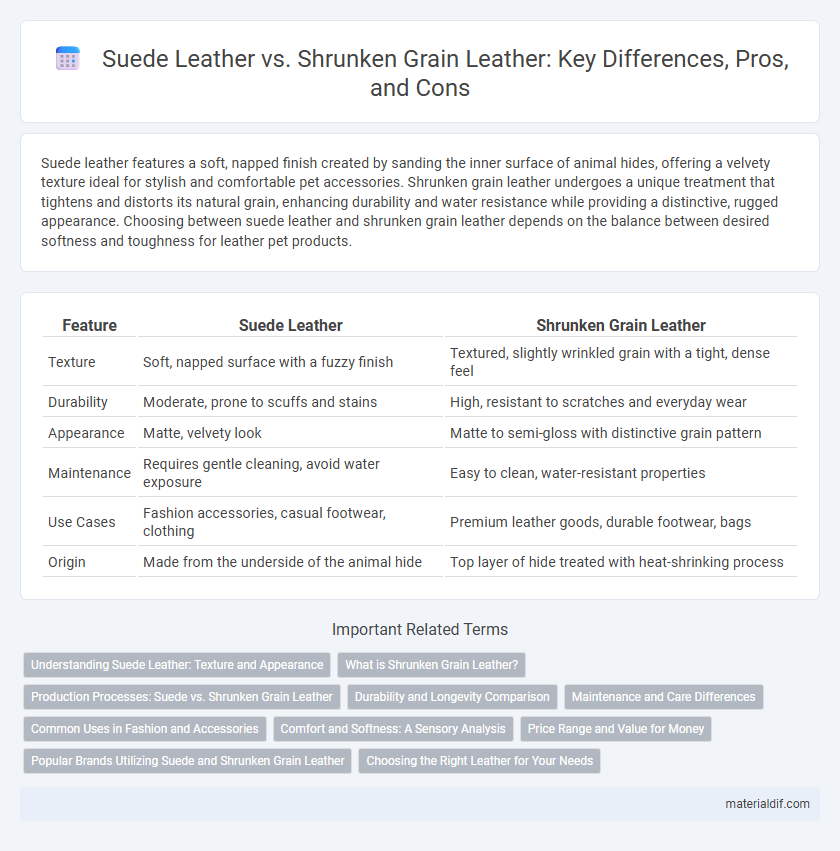Suede leather features a soft, napped finish created by sanding the inner surface of animal hides, offering a velvety texture ideal for stylish and comfortable pet accessories. Shrunken grain leather undergoes a unique treatment that tightens and distorts its natural grain, enhancing durability and water resistance while providing a distinctive, rugged appearance. Choosing between suede leather and shrunken grain leather depends on the balance between desired softness and toughness for leather pet products.
Table of Comparison
| Feature | Suede Leather | Shrunken Grain Leather |
|---|---|---|
| Texture | Soft, napped surface with a fuzzy finish | Textured, slightly wrinkled grain with a tight, dense feel |
| Durability | Moderate, prone to scuffs and stains | High, resistant to scratches and everyday wear |
| Appearance | Matte, velvety look | Matte to semi-gloss with distinctive grain pattern |
| Maintenance | Requires gentle cleaning, avoid water exposure | Easy to clean, water-resistant properties |
| Use Cases | Fashion accessories, casual footwear, clothing | Premium leather goods, durable footwear, bags |
| Origin | Made from the underside of the animal hide | Top layer of hide treated with heat-shrinking process |
Understanding Suede Leather: Texture and Appearance
Suede leather is characterized by its soft, napped texture resulting from the inner surface of animal hides, offering a velvety feel and matte finish. Unlike shrunken grain leather, which retains a smooth and compact grain structure with natural shrinkage patterns, suede emphasizes a plush, fibrous appearance with greater breathability. This tactile softness and distinctive fuzziness define suede's unique aesthetic, often preferred for luxury footwear and fashion accessories.
What is Shrunken Grain Leather?
Shrunken grain leather is a type of leather characterized by its distinct textured surface created through a specialized shrinking process that tightens the grain, enhancing durability and a unique crinkled appearance. Unlike suede leather, which is made from the underside of the hide and has a soft, napped finish, shrunken grain leather maintains the leather's outer grain surface with a pronounced, textured pattern. This process not only strengthens the leather but also improves its resistance to wear and adds a sophisticated, vintage aesthetic.
Production Processes: Suede vs. Shrunken Grain Leather
Suede leather is produced by buffing the inner surface of the hide to create a soft, napped finish, often requiring additional sanding and brushing techniques to achieve its characteristic texture. Shrunken grain leather undergoes a specialized tanning process involving controlled shrinking and embossing, which tightens the natural grain pattern and enhances durability while maintaining a smooth, firm surface. The distinct production methods result in suede being more porous and delicate, whereas shrunken grain leather offers increased resistance to wear and tear.
Durability and Longevity Comparison
Suede leather offers a soft texture but tends to be less durable due to its exposed fibrous surface, making it more prone to stains and wear over time. Shrunken grain leather, treated through a special process that tightens and compresses the leather fibers, boasts enhanced durability and resistance to abrasion, ensuring a longer lifespan even under heavy use. Choosing shrunken grain leather over suede results in footwear or accessories that maintain structural integrity and aesthetic appeal for years.
Maintenance and Care Differences
Suede leather requires consistent brushing with a soft-bristle brush to maintain its velvety texture and prevent dirt buildup, while avoiding water exposure that can cause staining. Shrunken grain leather demands regular conditioning with specialized leather creams to preserve its unique textured surface and prevent cracking. Both types benefit from storing in cool, dry environments and using protective sprays to enhance durability and appearance.
Common Uses in Fashion and Accessories
Suede leather is commonly used in fashion for soft, flexible items like jackets, shoes, and gloves, prized for its distinctive napped finish and breathability. Shrunken grain leather is favored in high-end accessories such as handbags, wallets, and belts due to its unique textured appearance and enhanced durability. Both materials are popular for combining style with functional wear, each catering to different aesthetic and practical demands in fashion.
Comfort and Softness: A Sensory Analysis
Suede leather offers a velvety texture with a plush, softly napped finish that enhances tactile comfort and provides a warm, cozy feel on the skin. Shrunken grain leather features a uniquely textured surface with pronounced grain patterns, delivering a firmer touch yet maintaining supple flexibility that molds to the wearer's movements. Both materials excel in softness, but suede leather tends to prioritize delicate smoothness, while shrunken grain leather balances robust texture with breathable comfort.
Price Range and Value for Money
Suede leather generally falls within a moderate price range due to its soft texture and widespread availability, offering good value for casual and fashion-focused items. Shrunken grain leather commands a higher price point owing to its durability and distinctive textured finish, making it a worthwhile investment for long-lasting luxury goods. Choosing between the two depends on budget preferences and the desired balance between aesthetic appeal and durability.
Popular Brands Utilizing Suede and Shrunken Grain Leather
Suede leather, known for its soft texture and matte finish, is prominently used by luxury brands like Gucci and Prada to create footwear and accessories that emphasize elegance and comfort. Shrunken grain leather, valued for its distinctive wrinkled pattern and durability, is favored by brands such as Coach and Mulberry for crafting high-quality handbags and wallets. Both leather types offer unique aesthetics and functionalities, making them popular choices in the premium fashion industry.
Choosing the Right Leather for Your Needs
Suede leather offers a soft, velvety texture ideal for fashion and interior applications requiring a delicate finish, while shrunken grain leather provides a durable, grain-enhanced surface perfect for rugged use and longevity. Suede requires careful maintenance to prevent staining and water damage, whereas shrunken grain leather resists wear and develops a rich patina over time. Selecting between suede and shrunken grain leather depends on lifestyle demands, desired aesthetic, and maintenance willingness.
Suede Leather vs Shrunken Grain Leather Infographic

 materialdif.com
materialdif.com